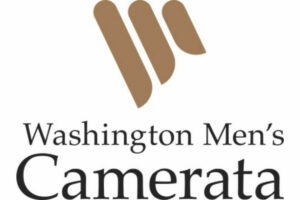Streets of Washington is the brilliant blog covering some of DC’s most interesting buildings and history written by John DeFerrari. John is also the author of the equally brilliant Lost Washington DC. Following is a new occasional series called ‘Streets of Washington Presents…’ featuring some fascinating buildings around town. The Evening Star Building has always been one of my favorites. I was blown away to learn about the history. As a result it is a long post, not all contributions will be this extensive. Hope you enjoy it as much as I did.
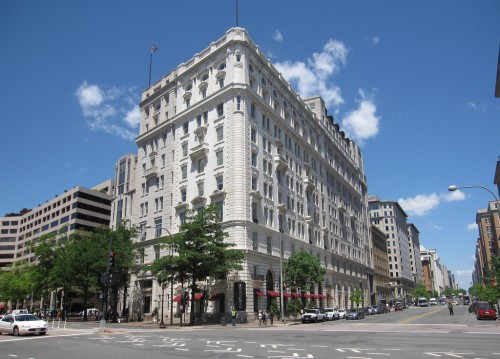
It was a sad day in Washington in August 1981 when The Washington Star ceased publication after more than 128 years of service. The Star’s tenure had stretched back before the Civil War, an amazing run that witnessed the historic sweep of the city’s development from small town to sophisticated metropolis. “The Rock of Gibraltar in Washington journalism is The Washington Star, one of the world’s really great newspapers,” historian Fred A. Emery wrote in 1935. The rise and fall of this bygone institution has its own grand sweep, with its greatest achievements occurring when it was quartered in the majestic marble building at 11th Street and Pennsylvania Avenue, NW, that still bears its name today.
The Star began inauspiciously enough in December 1852, one of dozens of newspapers that sprang up for limited runs in 19th century Washington City. In fact, two other D.C. newspapers had already used the Star name, the Columbian Star from 1822 to 1827, and the first Washington Star in 1841. The third Star, the one that would matter, began as a four-page broadsheet with a run of 250 copies, printed on a hand press in a small office at 8th and D Streets, NW. The paper’s first owner, Captain Joseph Borrows Tate, sought to distinguish the Star from all the other rags published throughout the city by striking a tone of impartiality: “The Star is to be free from party trammels or sectarian influences…devoted in an especial manner to the local interests of the beautiful city which bears the honored name of Washington.” The paper’s neutral stance and focus on local news became its trademark and, in time, gave it broad appeal and commercial success. It also led at times to overly innocuous reportage, as in this oft-quoted remark by reporter William Tucker that appeared in the paper’s first edition: “Our courts are sitting, but the business with which they are engaged is not of a very interesting character.”
Tate sold the paper within a year to William Wallach (1812-1871), an aggressive Texan who worked hard to build up the business, moving its office to the southwest corner of 11th and Pennsylvania in 1854. Wallach hired a promising young reporter, Crosby S. Noyes (1825-1908), in 1853, and Noyes quickly became the Star‘s star. One of his many assignments was to report on the hanging of John Brown at Harper’s Ferry, WV, in 1859, which he did in flowery, dramatic prose. The Star maintained an anti-slavery stance in those days and, once the Civil War began, was decidedly pro-Union, despite the strong Southern sentiments then common in Washington.
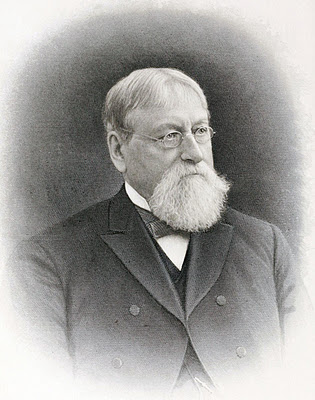
Crosby S. Noyes (Source: Wikimedia Commons)
The paper grew in prestige during the war years, aided by its exclusive connections with an early incarnation of the Associated Press. Through the AP, the Star‘s vivid coverage of the war’s impact on Washington was relayed across the country. The New York Times often reprinted war reports from the pages of the Star, and the paper’s prestige increased. Supposedly, as soon as Abraham Lincoln finished delivering his second inaugural address, he handed the text to Crosby Noyes so that it could be printed in the Star.
In 1867, Wallach retired and the paper was bought by Noyes and four other investors: Samuel H. Kauffmann (1829-1906), Alexander “Boss” Shepherd (1835-1902), Clarence D. Baker, and George W. Adams. Shepherd, who would become governor of D.C. in 1873, sold his share of the enterprise within a few years, as did Baker, and Adams remained a behind-the-scenes investor. That left Noyes and Kauffmann to establish a family dynasty that would preside over the Star for another 100 years. Noyes exercised editorial control, while Kauffmann served as publisher and handled the business side.
Continues after the jump.
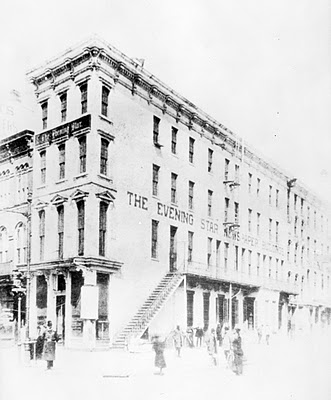
The Star‘s new home in 1881 (Source: Library of Congress).
In 1881, the Star was forced to move from its quarters on the south side of Pennsylvania Avenue to make way for construction of the grand Post Office Department building, so well-known now for its iconic clock tower. Kauffmann and Noyes decided to move directly across the street to a narrow, four-story building on the northwest corner of 11th and Pennsylvania. The paper was steadily growing during these years, and the new building was almost immediately too small. The company gradually acquired adjacent properties on Pennsylvania and 11th until it had a large enough plot to build a monumental skyscraper of a building.
The project began in 1897 with many of the leading architects of the day participating in a competition to design the Star‘s new home. James G. Hill, architect of such prominent buildings as the Bureau of Engraving and Printing and the Stoneleigh Court Apartments, submitted a proposal, as did the firm of Hornblower & Marshall, designers of the Smithsonian’s Natural History Building, and Glenn Brown (1854-1932), an influential secretary of the American Institute of Architects and author of the landmark History of the United States Capitol. The winner, however, was William J. Marsh (1864-1926). Marsh had just started an independent practice with Walter G. Peter (1868-1945), whom he had met while they were both working at Hornblower & Marshall. Marsh may have had the inside track on this competition since he had previously designed homes for Crosby Noyes and two of his sons.
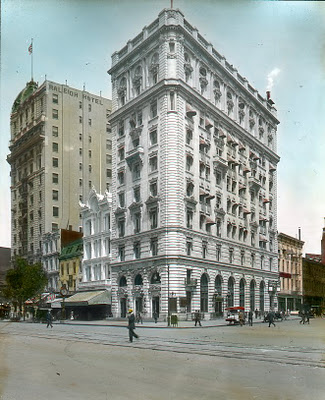
The Evening Star Building prior to 1918. The tall building to the left is the Raleigh Hotel. (Source: DC Public Library Commons)
Marsh designed an ostentatious, marble-faced office tower in the then-fashionable Beaux-Arts style. The shining white structure was a powerful statement of the Star‘s position of power and pre-eminence. In comparison, the Washington Post‘s smaller grey-granite building up the street, done in the Romanesque-Revival style, looked out-of-date. A postcard of the new building unabashedly proclaims, “The Evening Star Building of white marble is the most beautiful newspaper building in the world.”
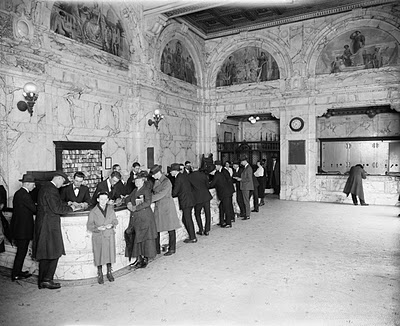
The Star’s business office, circa 1921 (Source: Library of Congress).
The building was completed and opened for business in June 1900. As described in great detail in the rival Washington Times, its interior held many wonders. Inside the Pennsylvania Avenue entrance, one passed through a marble-clad lobby to the richly-decorated business office. The walls were clad in exquisite white Paonazzo marble from the famous Carrara quarries of Italy and carved into elegant Renaissance Revival arches and pilasters. Frederick Dielman (1847-1935), a celebrated painter who had recently produced murals for the new Library of Congress building, was commissioned to prepare seven great allegorical paintings of the newspaper industry for the lunettes in the upper portions of the walls. The effect was of being in a Renaissance church or grand library rather than the business office of a newspaper.
Editorial offices were on the seventh floor, with a commanding view of the city from the windows to the west and south. Editors (the news editor, city editor, telegraph editor) had their desks along the windows, all equipped with telephones, electric bells, and pneumatic tubes for sending messages around the building. The open space in the middle of the room was filled with roll-top reporters’ desks, a typewriter on each. On the other side, a row of telephones stood at the ready, providing instant communications with the Senate, House of Representatives, City Hall, and District Building. It was the height of modern journalistic efficiency.
On the eighth floor was the composing room, in a double space that extended through the ninth floor to provide a cavernous, skylit working space. It was outfitted with 18 of the latest Morgenthaler linotype machines, sophisticated devices that set lines of type in cast bars of lead for use on the two enormous printing presses down in the basement. The equally large basement printing plant included not just the presses but also electric generating equipment capable of independently supporting all of the building’s needs.
Management of the paper passed to a new generation with the deaths of Samuel Kauffmann in 1906 and Crosby Noyes in 1908. Two of Noyes’ sons took over, Frank taking Kauffmann’s place as president in 1906 and his brother Theodore becoming editor in 1908. Under the Noyes brothers, the Star’s greatest period of expansion took place, and it became one of the most profitable newspapers in the business. It continued to focus on local news and printed only the safest of opinions on its editorial pages, thus ensuring that none of its many advertisers were offended. Meanwhile, its competitors languished. The Post had sullied its reputation by seeming to incite the race riots of 1919. According to Constance McLaughlin Green, “Newspapermen despised the Washington Post, a ‘poison sheet’ without moral integrity.” Of the other two major papers, the Times had “swung far to the right,” according to Green, thus marginalizing itself, while the Herald “offered a bland diet only occasionally spiced with biting, politically loaded comments.” With such anemic competition, the Star could afford to be arrogant.
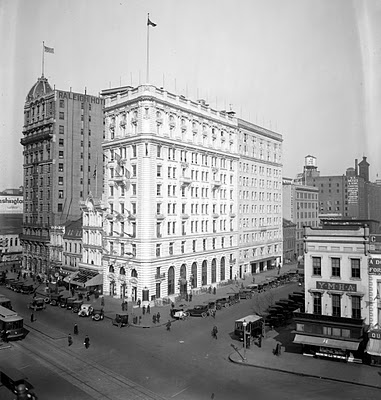
The Star Building circa 1921, after construction of the 1918 annex (Source: Library of Congress).
In 1918, the company built a large annex next to the original building along 11th Street, and it became the industrial heart of the expanded business. The new space was equipped with no less than 34 Morgenthaler linotype machines and four presses in the basement. On an average day, 890 4-pound ingots of lead were melted down to make the day’s press plates. (The metal was melted down and re-used each day.) A typical print run in 1927 was 100,000 copies of a 32-page paper, requiring 38 massive rolls of newsprint, or 596 miles of paper. The finished papers were loaded on to 17 trucks for distribution across the city each weekday afternoon and Sunday morning.
Everyone seems to agree that the real turning point for the newspaper—from rising star to falling star, as it were—came in 1954, when the Post absorbed the Times-Herald. (The Times and the Herald had merged in 1939.) The Times-Herald had had a slightly higher circulation than the Star, although the Star‘s advertising volume far outpaced any of its competitors. But the acquisition of the Times-Herald put the Post well ahead of the Star in circulation for the first time—over 380,000 by 1955 compared to the Star‘s 250,000. By 1959, the Post pulled ahead in advertising volume as well, and the Star never caught up. While the Post had taken over the spot as the city’s newspaper of record, having come a long way from its “poison sheet” days of the 1920s, top management of the Star seemed oblivious to the sea-changes. Insular and used to longstanding success, they thought their paper was invulnerable. Instead, it was doomed.
As if to symbolically punctuate the Star‘s decline, the company decided in the late 1950s to abandon its venerable home on Pennsylvania Avenue and construct a new building at 225 Virginia Avenue, SE. The move gained key logistical advantages for the paper’s printing operations; the soon-to-be-constructed I-395 freeway would provide direct access for speedy afternoon distribution, and a railroad spur offered equally direct access to newsprint and other raw materials. In addition, the new building boasted roughly three times the floor space of the old one. Nevertheless, the company had traded an elegant structure at a prestigious address for a hulking, utilitarian box in an out-of-the-way, run-down area.
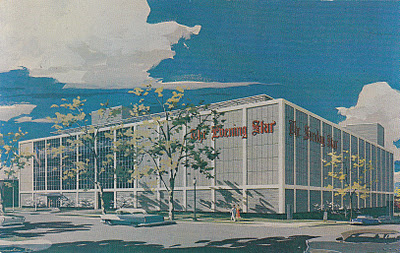
Postcard rendering of the new building (Author’s collection).
The demise of the Star was a long and drawn-out affair. Circulation actually continued to increase throughout the 1960s, although advertising revenue steadily dropped off. The afternoon format became more and more of a liability, no longer fitting the daily routines of a changing culture and also posing distribution challenges. “Realistically, it was probably hopeless by ’65 or ’66,” a former executive was quoted as saying in the Star‘s final edition. As the paper relentlessly lost money, the Kauffmann and Noyes families began to look for an outside buyer. In 1974, a wealthy Texas banker, Joe L. Allbritton, took control of the paper, eventually buying out the shares owned by the Kauffmann and Noyes families.
Allbritton wanted to turn the paper around, but he faced insurmountable odds. A key part of his strategy was to leverage the income from the company’s profitable WMAL broadcasting stations to cover the paper’s losses while fixes were being planned. However, the Federal Communications Commission balked at Allbritton holding on to two different mass media outlets in the same market. Tense times at the paper ensued, with staff accepting pay cuts and a reduced work week to keep the business alive. In 1978, four years after taking over, Allbritton sold the Star to Time Inc. The media giant made more changes, bringing in new editorial leadership, changing the physical design of the paper, and switching to morning delivery. It didn’t help. After just three more years, Time closed the Star for good in 1981.
Meanwhile, the old Evening Star Building endured quietly on Pennsylvania Avenue. Initial plans, after its namesake had moved out, were to convert it to a 330-room hotel. Instead, it was converted to generic office space, and much of it was rented to the federal government. As various “modernizations” were undertaken, nothing of the original interior decoration was preserved—the Carrara marble, the mahogany trim, the Dielman murals—all vanished. In 1981, the owners proposed a massive renovation and enlargement of the building, a project that was finally carried out 9 years later. The 1918 addition on 11th Street was torn down in 1987, as were smaller structures abutting the building on Pennsylvania Avenue, and a large new addition, designed in a style sympathetic with the original, was put up in their place. The Evening Star Building is now one of the most valuable properties in downtown Washington.
The 1959 building in Southeast was sold to the Post, which used it as a printing plant for many years. The D.C. government leased the building in 2007 with the intention of using it as a new police headquarters but subsequently determined that that option would be too expensive. The city bought the building outright in 2009, and it is currently being extensively renovated to house several other D.C. government agencies.
Thanks to Kim Williams, D.C. Historic Preservation Office, for her assistance with this article. Sources included Fred A. Emery, “Washington Newspapers” in Records of the Columbia Historical Society (Vol. 37-38, 1937); Merrill E. Gates, Men of Mark in America (1906); Constance McLaughlin Green, Washington: A History of the Capital, 1800-1950 (1962); John Clagett Proctor, Washington Past and Present: A History (1930); Pamela Scott and Antoinette Lee, Buildings of the District of Columbia (1993); Washington Board of Trade, The Book of Washington (1927); a draft National Register of Historic Places nomination for the Evening Star building from 1990; and, of course, numerous newspaper articles from the Star as well as its chief rivals.
Recent Stories

Photo by Clif Burns Ed. Note: If this was you, please email [email protected] so I can put you in touch with OP. “Dear PoPville, Hey – you stopped me while…

Unlike our competitors, Well-Paid Maids doesn’t clean your home with harsh chemicals. Instead, we handpick cleaning products rated “safest” by the Environmental Working Group, the leading rating organization regarding product safety.
The reason is threefold.
First, using safe cleaning products ensures toxic chemicals won’t leak into waterways or harm wildlife if disposed of improperly.

Looking for something campy, ridiculous and totally fun!? Then pitch your tents and grab your pokers and come to DC’s ONLY Drag Brunch Bingo hosted by Tara Hoot at Whitlow’s! Tickets are only $10 and you can add bottomless drinks and tasty entrees. This month we’re featuring performances by the amazing Venus Valhalla and Mari Con Carne!
Get your tickets and come celebrate the fact that the rapture didn’t happen during the eclipse, darlings! We can’t wait to see you on Sunday, April 21 at 12:30!
Frank’s Favorites
Come celebrate and bid farewell to Frank Albinder in his final concert as Music Director of the Washington Men’s Camerata featuring a special program of his most cherished pieces for men’s chorus with works by Ron Jeffers, Peter Schickele, Amy
Cinco de Mayo Weekend @ Bryant Street Market
SAVE THE DATE for Northeast DC’s favorite Cinco de Mayo celebration at Bryant Street NE and Bryant Street Market!
Cinco de Mayo Weekend Line up:
Friday, May 3:





